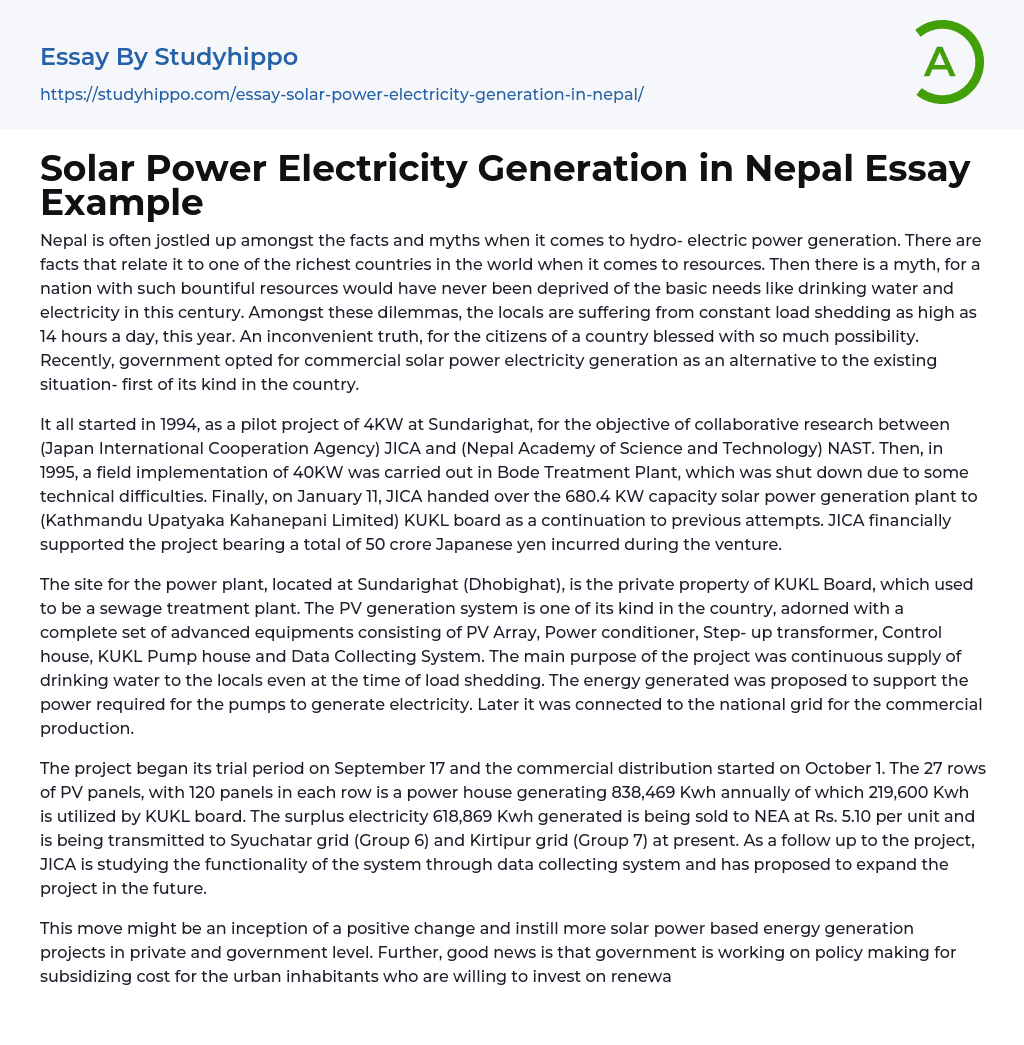

Solar Power Electricity Generation in Nepal Essay Example
Nepal is often jostled up amongst the facts and myths when it comes to hydro- electric power generation. There are facts that relate it to one of the richest countries in the world when it comes to resources. Then there is a myth, for a nation with such bountiful resources would have never been deprived of the basic needs like drinking water and electricity in this century. Amongst these dilemmas, the locals are suffering from constant load shedding as high as 14 hours a day, this year. An inconvenient truth, for the citizens of a country blessed with so much possibility. Recently, government opted for commercial solar power electricity generation as an alternative to the existing situation- first of its kind in the country.
It all started in 1994, as a pilot project of 4KW at Sundarighat, for the
...objective of collaborative research between (Japan International Cooperation Agency) JICA and (Nepal Academy of Science and Technology) NAST. Then, in 1995, a field implementation of 40KW was carried out in Bode Treatment Plant, which was shut down due to some technical difficulties. Finally, on January 11, JICA handed over the 680.4 KW capacity solar power generation plant to (Kathmandu Upatyaka Kahanepani Limited) KUKL board as a continuation to previous attempts. JICA financially supported the project bearing a total of 50 crore Japanese yen incurred during the venture.
The site for the power plant, located at Sundarighat (Dhobighat), is the private property of KUKL Board, which used to be a sewage treatment plant. The PV generation system is one of its kind in the country, adorned with a complete set of advanced equipments
consisting of PV Array, Power conditioner, Step- up transformer, Control house, KUKL Pump house and Data Collecting System. The main purpose of the project was continuous supply of drinking water to the locals even at the time of load shedding. The energy generated was proposed to support the power required for the pumps to generate electricity. Later it was connected to the national grid for the commercial production.
The project began its trial period on September 17 and the commercial distribution started on October 1. The 27 rows of PV panels, with 120 panels in each row is a power house generating 838,469 Kwh annually of which 219,600 Kwh is utilized by KUKL board. The surplus electricity 618,869 Kwh generated is being sold to NEA at Rs. 5.10 per unit and is being transmitted to Syuchatar grid (Group 6) and Kirtipur grid (Group 7) at present. As a follow up to the project, JICA is studying the functionality of the system through data collecting system and has proposed to expand the project in the future.
This move might be an inception of a positive change and instill more solar power based energy generation projects in private and government level. Further, good news is that government is working on policy making for subsidizing cost for the urban inhabitants who are willing to invest on renewable energy resources for power generation. Hopefully, this will heal the urban inhabitants from the ail of prolonged hours of load shedding in the future.
- Energy Development essays
- The elements essays
- Voltage essays
- Solar Energy essays
- Nuclear Energy essays
- Alternative Energy essays
- Teenagers essays
- Millennials essays
- Teenage Drinking essays
- Teenage Suicide essays
- Oxygen essays
- Atmosphere essays
- Coral Reef essays
- Desert essays
- Earth essays
- Ocean essays
- Lake essays
- Sea essays
- Biodiversity essays
- Natural Environment essays
- Forest essays
- Soil essays
- Water essays
- Rainbow essays
- Ecosystem essays
- Volcano essays
- Wind essays
- Forestry essays
- Bottled Water essays
- Atom essays
- Big Bang Theory essays
- Density essays
- Electricity essays
- Energy essays
- Force essays
- Heat essays
- Light essays
- Motion essays
- Nuclear Power essays
- Physiology essays
- Sound essays
- Speed essays
- Temperature essays
- Thermodynamics essays
- Anthropology essays
- Audience essays
- Charity essays
- Cultural Competence essays
- Emile Durkheim essays
- Gender Roles essays



